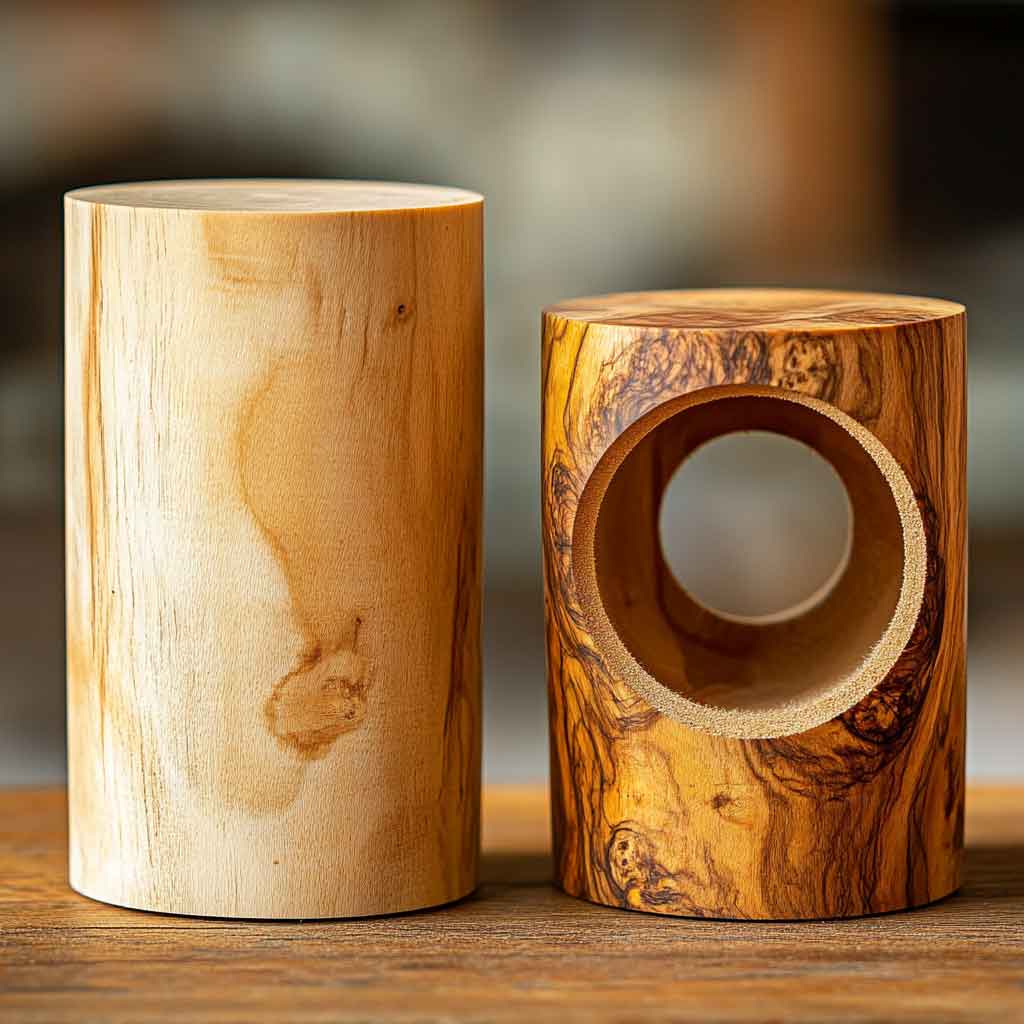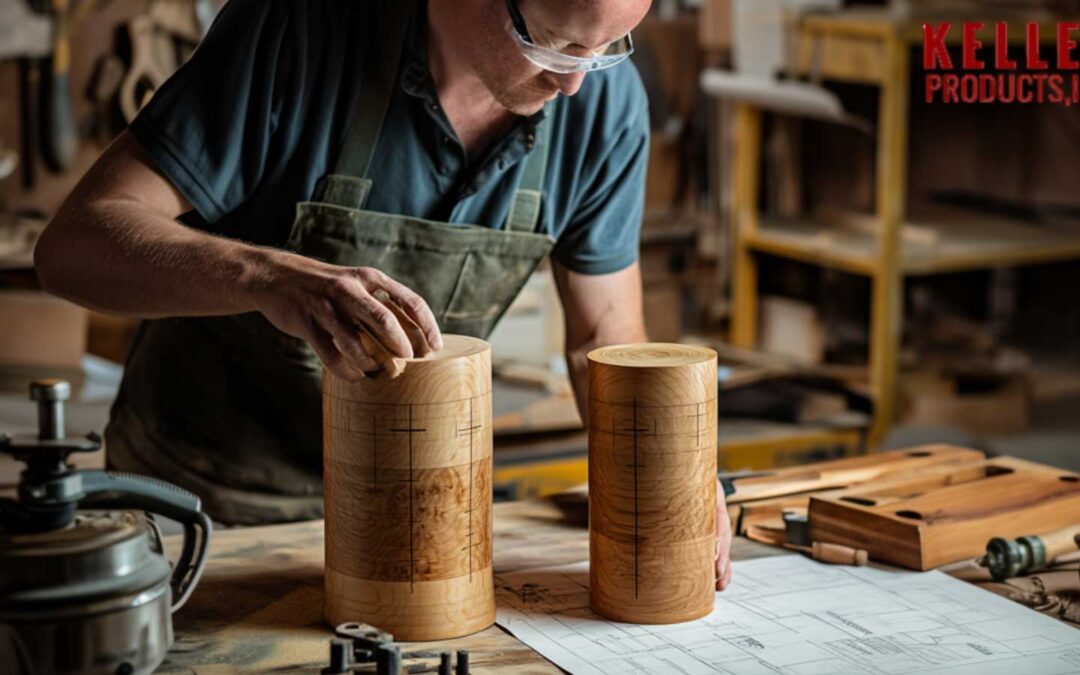Wooden cylinders are a fundamental component in various woodworking and engineering applications. Understanding the differences between hollow and solid wooden cylinders can help you decide which type to use in your projects. This guide explores the characteristics, strengths, and ideal uses of hollow and solid wooden cylinders, offering insights into their applications and how they perform under different conditions.
What Defines Cylinder Strength?
The strength of a wooden cylinder is determined by several factors. Understanding these elements helps engineers and designers choose the best cylinder for their requirements. Let’s detail each factor to uncover how they influence cylinder strength.
1. Material Properties
- Wood Type: The choice of wood profoundly affects a cylinder’s strength. Hardwoods, such as:
- Oak: Renowned for its dense grain and high compressive strength, oak is ideal for applications requiring durability and load-bearing capacity.
- Maple: Offers a high degree of hardness and strength, making it suitable for structural elements and heavy-duty applications.
Softwoods, like:
- Pine: While lighter and easier to work with, pine has lower compressive strength than hardwoods. It’s often used in less demanding applications or where reinforcement is possible.
- Grain Direction: The orientation of the wood grain impacts strength. Cylinders with grain running parallel to the load direction offer superior strength and resistance to bending. Conversely, cross-grain configurations may result in weaker structural support.
- Moisture Content: The wood’s moisture content affects its durability and strength. Higher moisture levels can lead to warping or weakening over time, while properly dried wood maintains its integrity and stability.
2. Structural Geometry
- Wall Thickness: For wooden hollow cylinders, the thickness of the walls plays a crucial role in their rigidity and load capacity. A thicker wall generally enhances strength but adds weight. Key considerations include:
- Increased Rigidity: Thicker walls provide excellent resistance to bending and deformation.
- Optimal Balance: Designers must balance wall thickness with weight constraints to achieve desired performance.
- Diameter and Height: The dimensions of both hollow and solid cylinders influence their structural integrity. For hollow cylinders:
- Diameter: Larger diameters can support higher loads but may need proportional increases in wall thickness to maintain strength.
- Height: Taller cylinders may require additional reinforcement to prevent buckling under compressive forces.
- Solid Cylinders: Solid cylinders’ continuous material ensures uniform support. This design makes them particularly robust against compressive forces, as the material’s strength is distributed evenly throughout the cylinder’s volume.

Solid Cylinder: Characteristics and Applications
Solid wooden cylinders are the cornerstone of strength and stability in various engineering and architectural applications. Their dense, uniform composition provides unmatched load-bearing capabilities, making them indispensable in situations where reliability is non-negotiable.
Common Uses: Shafts, Rods, and Columns
- Support Columns: Solid wooden cylinders are frequently used as support columns in construction and architecture. Picture the grand entrance of a stately building where towering wooden columns bear the weight of an expansive roof. These solid wooden cylinders provide the high compressive strength needed to support substantial loads without the risk of buckling. Their stability ensures that the structure remains reliable and durable for decades, even under the pressure of environmental stresses like wind and seismic activity.
- Furniture Legs: In the furniture industry, solid wooden cylinders are the legs of sturdy tables, chairs, and cabinets. Imagine the legs of a rustic dining table crafted from solid wood cylinders, providing unwavering support for heavy meals, family gatherings, and daily use. These cylinders contribute to the furniture’s aesthetic appeal and offer the durability necessary to withstand constant use and heavy loads, ensuring the wood furniture parts remain functional and long-lasting.
- Shafts: Solid wooden cylinders are also essential in machinery, where they function as shafts. The load-bearing capability of these cylinders is critical in such applications, ensuring the consistent transfer of mechanical power and torque. The robust construction of solid wooden cylinders guarantees minimal deformation, allowing the machinery to operate smoothly and efficiently under stress.
Hollow Cylinder: Characteristics and Applications
Hollow cylinders are essential in many engineering and architectural applications due to their unique structural properties. Unlike solid cylinders, hollow cylinders offer a combination of strength and reduced weight, making them ideal for situations where minimizing material use and optimizing performance are critical.
Key Applications of Hollow Cylinders
- Support Structures: Hollow cylinders, such as columns and beams, are widely used in construction as support structures. Their shape allows them to handle compressive forces efficiently while being lighter than their solid counterparts, which makes them suitable for large-scale architectural projects where weight reduction is crucial.
- Pipes and Tubes: One of the most common uses of hollow cylinders is in piping systems. Hollow cylinders serve as pipes for transporting fluids and gases, with their hollow design allowing for efficient flow while maintaining structural integrity under pressure.
- Axles and Shafts in Machinery: Hollow cylinders are often used as axles and shafts in machinery. Their hollow nature reduces weight without significantly compromising strength, which helps optimize mechanical systems’ performance by reducing the overall load and improving efficiency.
The Structural Advantages of Hollow Cylinders
Hollow cylinders are preferred in applications where material efficiency and load-bearing capacity are important. Their ability to distribute stress evenly across the surface makes them particularly resilient in high-pressure environments. Additionally, their reduced weight compared to solid cylinders allows for easier handling and installation, making them a versatile choice in both industrial and construction settings.
Engineering Principles Behind Cylinder Strength
Understanding the engineering principles that govern cylinder strength is crucial for optimizing the design and functionality of both hollow and solid cylindrical structures. These principles focus on how these structures resist various forces and maintain integrity under load.
Moment of Inertia Explained
The moment of inertia is a fundamental concept in mechanics that measures an object’s resistance to angular acceleration, including bending and twisting. This property is critical in determining how well a cylinder can withstand torsional (twisting) forces:
- Higher Moment of Inertia in Hollow Cylinders: Hollow cylinders exhibit a higher moment of inertia than solid cylinders of equivalent mass due to their mass being distributed further from the center. This distribution allows them to resist twisting more effectively, making them especially suitable for applications involving rotational movements or where torsional stability is essential.
- Applications Benefiting from High Moment of Inertia: In automotive engineering, hollow cylindrical axles are used because they provide the necessary strength while minimizing weight, enhancing the vehicle’s overall performance. Similarly, in aerospace, hollow cylinders are preferred in wing spars and fuselage structures, where high torsional rigidity is required to endure dynamic aerodynamic loads.
Force and Stress Management in Cylindrical Structures
Understanding how hollow and solid cylinders manage forces and stresses is important for selecting the right structure for specific applications. This section combines the concepts of load and stress distribution to provide a comprehensive view of the mechanical properties and advantages of each type of cylinder.
Load and Stress Distribution in Hollow Cylinders
Hollow cylinders are designed to handle dynamic loads effectively due to their ability to distribute forces evenly across their walls. This uniform distribution minimizes localized stress concentrations, making them ideal for applications subject to varying or fluctuating forces, such as structural supports or components in machinery that endure bending and twisting. Key benefits include:
- Efficient Stress Management: The even stress distribution along the walls of hollow cylinders reduces weak points and enhances performance under dynamic loading conditions, extending the lifespan of the structure.
- Adaptability and Agility: Hollow cylinders are well-suited for applications where a balance of strength and flexibility is required, such as in structural supports or piping systems that face changing pressures.
Load and Stress Distribution in Solid Cylinders
Solid cylinders excel in static or heavy-duty applications due to their filled structure, which supports high compressive loads without deformation. The material strength is uniformly distributed throughout the cylinder, providing superior durability and load-bearing capacity. However, stress tends to concentrate more towards the center, which can be advantageous for direct compressive forces but may require careful management under bending or torsional loads. Key advantages include:
- Superior Load Handling: Solid cylinders can support significant static loads, making them ideal for heavy machinery, construction elements, and other applications requiring robust support.
- Durability and Strength: Their solid nature provides unmatched durability, though it’s important to consider the potential for internal stress concentrations under complex loading conditions, which could lead to fatigue or failure if not adequately managed.
Buckling Considerations
Buckling is a mode of failure that primarily affects slender structures subjected to compressive forces. Understanding and preventing buckling is crucial, especially in hollow cylindrical designs:
- Susceptibility to Buckling: Hollow cylinders, particularly long and slender ones, are more susceptible to buckling under axial loads. The risk increases with the cylinder’s length and the thinness of its walls.
- Design Strategies to Prevent Buckling: To ensure stability and resist buckling:
- Selecting Appropriate Wall Thickness: Adjusting the wall thickness according to the load and length can significantly enhance resistance to buckling.
- Material Choice: Using materials with a higher modulus of elasticity can improve buckling resistance by providing greater stiffness.
- Geometric Optimization: Incorporating features like flanges or ribs can increase the moment of inertia and reduce the likelihood of buckling under compressive stresses.
Choosing the Right Wood Product Manufacturer
Choosing the proper manufacturer for wooden cylinders is crucial for achieving excellence in your projects. At Keller Wood Products, we combine 75 years of craftsmanship with cutting-edge technology to deliver top-tier hollow and solid wooden cylinders. Our commitment to quality ensures that each product is meticulously crafted to meet the highest standards of durability and aesthetics.
Whether you need the lightweight efficiency of hollow cylinders or the robust strength of solid wood, Keller Wood Products is your go-to source for premium solutions. Contact us today to see how our expertise can elevate your next project.

